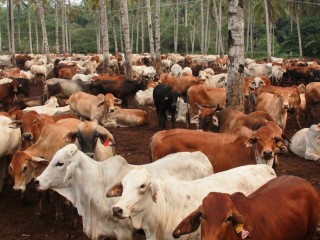 Meat and Livestock Australia says it sees a bright future for both boxed beef exports and live cattle exports into Indonesia, stating that Australia’s “great competitive advantage” is its ability to provide a diverse range of product to the market.
Meat and Livestock Australia says it sees a bright future for both boxed beef exports and live cattle exports into Indonesia, stating that Australia’s “great competitive advantage” is its ability to provide a diverse range of product to the market.
If Australia and Indonesia can overcome the political barriers that continue to hamper trade, the prospects for export growth to the market are enormous.
Indonesia has a population of more than 240 million people and average annual beef consumption of close to 2kg per person. If that can be increased even slightly, it represents massive potential growth in the volume of beef the market will require.
The positive news for Australia’s cattle industry is that such growth is well on track to being achieved as the country’s population expands and the economic prosperity of its middle classes builds.
As a Muslim-dominated country, pork is not an option for most Indonesians, with beef, chicken and fish the most popular and readily available protein sources.
Despite the positive outlook, a shortage of supply is working against aspirations to grow beef consumption at present.
While local farmers are understandably enjoying the higher prices they are commanding for their cattle following substantial cutbacks to cattle and beef imports this year, the resulting supply squeeze is said to be making beef too expensive for the average consumer which in turn is triggering a shift towards lower-priced chicken.
Meat and Livestock Australia says South East Asia represents its third-largest area of investment and Indonesia is a “significantly important component” of that.
Managing director Scott Hansen said Australia’s great competitive advantage was the diversity of its production systems and ability to offer the full spectrum of products from live feeder cattle and highly marbled Wagyu through to frozen beef, grassfed organic and vacuum packed primals.
A media report last week suggested MLA saw a brighter future for boxed beef into Indonesia, which some live exporters interpreted as a sign that MLA is winding back on its live export investment.
However Mr Hansen said the assertion was off track, and the company saw a “continued important and vital role” for Australia’s live cattle trade to Indonesia.
MLA’s total investment on live export for 2012-13, guided by a taskforce of live exporters and cattle producer representatives, has been set at $8m. That is slightly down on last year, but more than previous years. The majority will be spent in Indonesia.
The focus of the live export budget this year is on helping existing and new customers to implement the changes required to comply with Australia’s Export Supply Chain Assurance System (ESCAS), so they can continue to receive Australian cattle in future.
The work typically involves performing gap analyses with customers to identify what each requires to meet the requirements of an audit, and then providing technical advice, staff training and assistance with writing standard operating procedures and manuals as required.
Since September last year MLA had funded 567 consultant days in Indonesia, and there was still more to be done as it worked to help new supply chains become customers of Australian cattle.
“Our primary focus over this next 12 months is continuing to support the commercial supply chains as they embrace and adopt the new regulatory requirements that are required for them to remain a customer.”
In terms of boxed beef, South East Asia, of which Indonesia is a significant component, is MLA’s third largest investment zone, accounting for a $4.2 budget provision this financial year.
Part of that expenditure will go towards helping Australian beef brands to increase their exposure, product range and foothold in food service and niche retail markets in Indonesia.
Secondly, and more generically, MLA is working to promote the nutritional benefits of beef to the broader Indonesia community, primarily through in-store demonstrations and point of sale promotional material.
“We know there is a great affinity with beef for Indonesians,” Mr Hansen said.
“It is the high priced protein so it is traditionally a celebratory meal.
“With the increasing prosperity and increasing incomes in the middle income bracket, we’re ensuring that the story and the message around the nutritional benefits of beef and the consumption of beef are told, particularly the importance of those nutritional benefits for children.”
“The increasing prosperity in the middle classes in SE Asia and Indonesia, combined with the rising population, bodes well for the increased consumption of beef and hence the market opportunity in these markets.”
